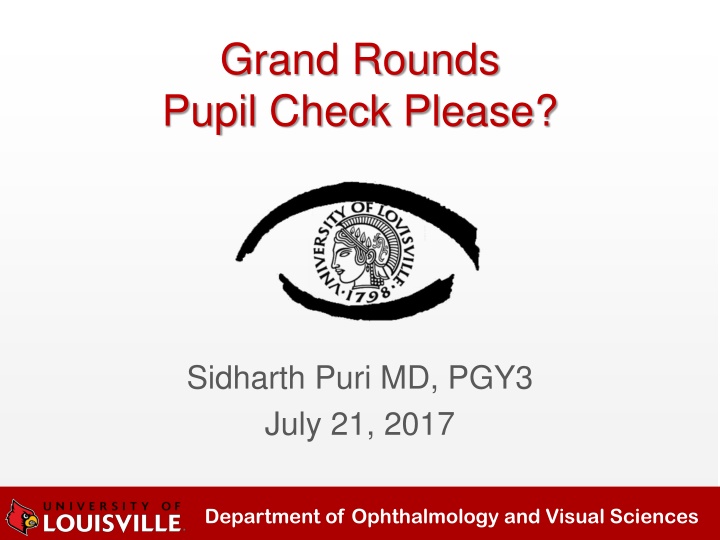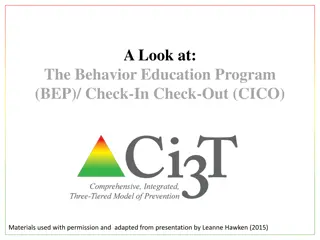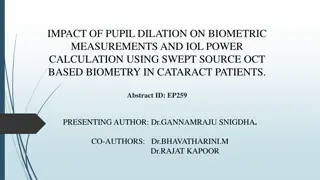
Ophthalmology Grand Rounds - Pupil Check by Dr. Sidharth Puri, MD, PGY3
Explore a case presentation involving a patient with vision loss post-operatively, accompanied by significant medical history and findings from various examinations, including pupil assessment, MRI results, and detailed ocular exams. Follow the diagnostic journey led by Dr. Sidharth Puri, MD, PGY3 in the Department of Ophthalmology and Visual Sciences.
Download Presentation

Please find below an Image/Link to download the presentation.
The content on the website is provided AS IS for your information and personal use only. It may not be sold, licensed, or shared on other websites without obtaining consent from the author. If you encounter any issues during the download, it is possible that the publisher has removed the file from their server.
You are allowed to download the files provided on this website for personal or commercial use, subject to the condition that they are used lawfully. All files are the property of their respective owners.
The content on the website is provided AS IS for your information and personal use only. It may not be sold, licensed, or shared on other websites without obtaining consent from the author.
E N D
Presentation Transcript
Grand Rounds Pupil Check Please? Sidharth Puri MD, PGY3 July 21, 2017 Department of Ophthalmology and Visual Sciences
Patient Presentation CC Loss of vision for days/weeks HPI 57 yo WF w/ pmhx of recurrent supraglottic SCC (first treated by chemoradiation 2015) s/p total laryngectomy, partial pharyngectomy, left neck dissection, left IJ resection on 12/28/2016. Underwent complicated post-operative course
HPI (contd) Patient nonverbal for several weeks post-operatively with significant periorbital and facial edema January 2017 Worsened agitation, underwent MRI Brain (1/22/17) Diffusion restriction involving the bilateral optic nerves extending from the optic canals to near the globes which is concerning for ischemic change. 1/24/17- Neck bleeding R carotid pseudoaneurysm stented Repeat imaging indicating left thalamocapsular hemorrhage February 2017 Seen by Neurosurgery and Stroke Team, with no acute findings on exam other than dilated sluggish pupils and mild R extremity weakness (2/2/2017) 2/13/17 Ophthalmology consulted due to ?vision changes Patient communication limited to nodding, but revealed to family she has been unable to see for days-weeks
MRI 1/22/17 DWI ADC
History (Hx) Past Ocular Hx - None Past Medical/Surgical Hx- Depression, Supraglottic SCC and as described Fam Hx -Noncontributory Meds Escitalopram, Synthroid, Metoprolol, Ferrous Sulfate, Pepcid, Multi Vitamin Allergies - NKDA Social Hx Former 40 pk year smoker, married
Review of Systems Negative for Headache, Jaw claudication, Temporal Tenderness, Nausea/Vomiting, Trauma
External Exam OD OS VA NLP NLP Fixed, nonreactive Pupils 5 mm 5 mm IOP 14 mmHg 14 mmHg EOM Full Full CVF UTO UTO
Anterior Segment Exam SLE OD OS External/Lids Wnl Wnl Conj/Sclera White and Quiet White and Quiet Cornea Clear Clear Ant Chamber Formed Formed Iris Wnl Wnl Lens 1+ NS 1+ NS
Posterior Segment Exam Fundus OD OS Optic Nerve 4+ diffuse pallor 4+ diffuse pallor Diffuse Whitish-yellow edema involving fovea Severe attenuation, sclerotic vessels temp macula and 360 periphery. Intact blood flow prox vessels Blunted reflex, Milder edematous changes Macula Vessels Severe attenuation Periphery Inferior pallor wnl
Differential Diagnosis Bilateral CRAO Recurrent/non-sequential BRAO Bilateral PION Bilateral Ophthalmic Artery Occlusion Combined mechanism with Hypoperfusion underlying pathophysiology
Assessment 57 yo WF 2 months s/p total larygnectomy, partial pharygnectomy, left and right neck dissection, left IJ sacrifice for supralarygneal SCC with NLP vision OU and bilateral CRAO
Perioperative Visual Loss Rare but devastating complication of sx 0.013% - 0.2% incidence (Berg et al 2010) Highest after cardiac and spinal sx Leading causes: AION, PION, CRAO, Pituitary Apoplexy, or Cortical Blindness
Postoperative AION Painless vision loss, disc edema Occlusion/hypoperfusion of posterior ciliary arteries Commonly after cardiac sx In setting of blood loss or hypotension Endogenous or exogenous vasoconstricting agents may contribute to choroidal and optic nerve ischemia Hypothermia during CABG may contribute to watershed infarction of optic nerve
Postoperative PION Less common than AION Normal ON and fundoscopic exam Infarction to intraorbital ON, supplied by pial vessels Commonly after spinal sx in prone position Prone increases orbital venous pressure and pressure on globe Anemia, hypotension also implicated
Many documented cases of ION following radical neck dissection Distention of ophthalmic veins, facial edema, can lead to ION E.g. venous distention leading to compression of orbital apex -> PION
Postoperative CRAO Variable vision at presentation 7 of 10 CRAO post spinal sx with NLP vision (Lee et al 2006) Cherry red spot in macula, white ground glass appearance to retina, attenuated arterioles, APD Likely due to external ocular compression Extensive pressure on globe leading to raised IOP above perfusion pressure and retinal ischemia Emboli also as source More likely following spinal sx in prone position (headrest prevents ocular perfusion)
Management/Treatment Urgent ophthalmologic evaluation & imaging Optimize hemodynamics, arterial oxygenation Unless acutely found, recommend observation Per AAO, no confirmed benefit for IOP lowering agents, steroids, anti-platelet agents, thrombolysis, hyperbaric oxygen
KEY POINTS ALWAYS conduct a thorough exam and listen to your patients Perioperative vision loss is a rare but devastating complication of non-ocular surgery Various causes range from ischemic optic neuropathy to CRAO Visual prognosis is severely guarded
References Berg KT, Harrison, AR, Lee MS. Perioperative visual loss in ocular and nonocular surgery. Clin Ophthalmol. 2010; 4: 531 546. Newman, NJ. Perioperative Visual Loss After Nonocular Surgeries. Am J Ophthalmol. 2008 Apr; 145(4): 604 610. Grover VK, Jangra K. Perioperative vision loss: A complication to watch out. J Anaesthesiol Clin Pharmacol. 2012 Jan-Mar; 28(1): 11 16. Lee LA, Roth S, Posner KL, et al. The American Society of Anesthesiologists Postoperative Visual Loss Registry: analysis of 93 spine surgery cases with postoperative visual loss. Anesthesiology. 2006;105(4):652 659.
Thank You Dr Sandhu Dr Pham Dr Piri Dr Hadayer
Home of the Innocents Back to School Vision Screening Saturday July 29, 2017 11AM-2PM Mandatory for all residents, Any and all attendings and med students welcome!






















